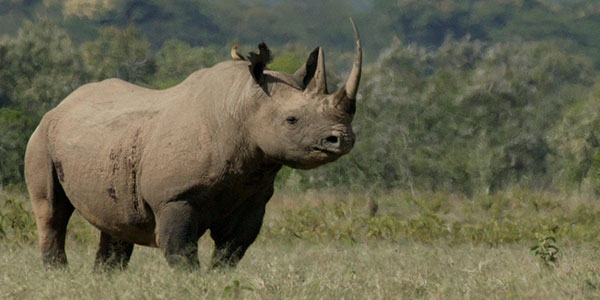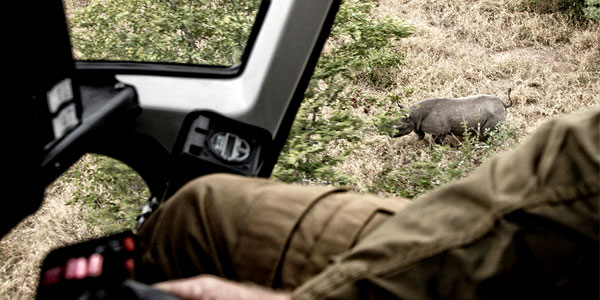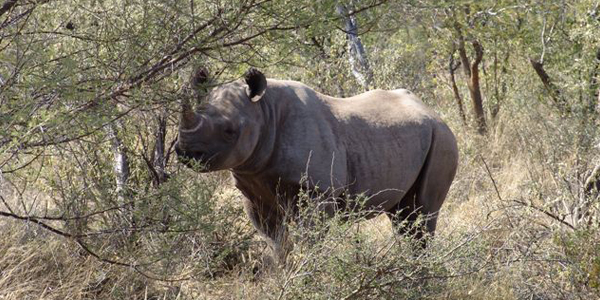Strategic Maneuvers (and Eternal Optimism) to Save Black Rhinos
 The past year will go down as one of the darkest on record for rhinos. We can’t ignore this unfortunate truth.
The past year will go down as one of the darkest on record for rhinos. We can’t ignore this unfortunate truth.
But amidst all the bad news, there remain glimmers of hope that strengthen our resolve to ensure the survival of rhinos across the globe.
Leading up to the year’s end, we’re going to be sharing stories of rhino conservation that’s working. We’re taking time to celebrate the small victories won by our projects in Africa and Asia, which inspire hope for the future of rhinos.
Strategic Maneuvers (and Eternal Optimism) to Save Black Rhinos
Africa’s black rhinos have not been hit by poaching nearly as hard as white rhinos — yet. Even so, the situation could change at a moment’s notice, so we can’t let our guard down for a second. If black rhinos, for the time being, are ‘safer’ than white rhinos, it is largely because they tend to be harder to find, preferring to live in dense bush with lots of thorny acacia.
They also survive because of the hope and generosity of rhino conservationists around the world.

In Africa, the fight to save rhinos is all-consuming, taking precedence over nearly every other activity. Together, we mourn defeats.
But we also have victories to celebrate.
Most of the good news comes out of Zimbabwe, where for nearly two decades the International Rhino Foundation has been supporting the Lowveld Rhino Trust’s intensive rhino management programs. The Lowveld conservancies hold large tracts of land converted from cattle ranches to wildlife management areas that safeguard these highly threatened species.
Zimbabwe currently holds Africa’s fourth largest populations of black and white rhinos — with numbers increasing at an average of 5% or more per year.
The country has seen its share of poaching. In 2008, hand in hand with its deepening economic crisis, Zimbabwe lost 144 rhinos to poaching. The Lowveld Rhino Trust undertook a series of strategic translocations of black rhinos from unsafe to safer areas.
This year, fewer than 10 animals have been lost.

The Lowveld Rhino Trust’s program is built on around-the-clock protection, weekly sighting of each individual rhino, and the ability to track every rhino in the population. Lowveld Rhino Trust staff look after rhinos on more than a million acres. These large land areas, which are critical to rhino population expansion, have the potential to sustain twice the number of rhinos that they hold today. Fortunately, lessons learned in the Lowveld can also be applied to other areas.
We’ve recently undertaken a rhino reintroduction project in Botswana — where just this season we quietly translocated 16 black rhinos from South Africa.
We’re working to save black rhinos in other ways, as well. Intelligence networks and advance warning systems are critical to rhino security everywhere.
Swaziland, a small African kingdom, had previously lost all of its black and white rhinos, as well as nearly two dozen other wildlife species, including elephants, lions, zebra, giraffe, wildebeest and buffalo. Today, nearly all have been returned to their native habitats. The war on poaching has been very successful, and rhino numbers are growing. Good relationships and free-flowing information from communities are key to keeping these populations safe.
In Phinda Nature Reserve in South Africa, we’ve funded an incentive system that rewards community members for information that helps to head off poaching incidents. We’ve helped build a new guard post and ranger quarters in South Africa’s Great Fish River Nature Reserve, which holds a significant population of black rhinos, and purchased a new radio system so that guards can respond rapidly to poaching incursions in Zimbabwe’s Gonarezhou National Park.
The common thread running through all these projects is hard work, passion partnership, and optimism — even in the face of a rampant poaching threat.

The war on poaching is fought on numerous fronts, some of which may be taking major casualties. Yet, other battles that we’re winning serve as models for the future.
We are incredibly grateful to all who help support these initiatives, and we call upon your help once again as we close another year.
Yes, there’s been some bad news for black rhinos, but there are also glimmers of hope.
Please give generously. Every gift, large or small, counts. Every gift helps us do more.


2 thoughts on “Strategic Maneuvers (and Eternal Optimism) to Save Black Rhinos”
Hi, I was just looking at a program on AlJazeera about endangered rhinos and a solution came to mind. I think we’re approaching the problem from the wrong end. Increasing the punishment for poachers will not solve the problem. First off, can a rhino live a normal life without its horn? Second, can the horn be surgically removed? If yes to both questions then why don’t we surgically remove the horns and take away the motive for killing them? Its a huge undertaking to do this but it is a sure way of saving the species. I’m sure we can raise the funds to do this. Just my simple solution to this problem.
That’s a good idea Malcolm. The horn can be removed and it has been tried before. Unfortunately, it takes days to track a rhino. When the poachers finally catch up and find the rhino has no horn they shoot and kill it anyway so they don’t make the same mistake and track the same rhino again. The best way to stop the poaching is to end the demand for it.